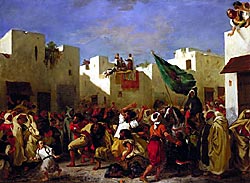
About 1855
Antoine-Louis Barye
Bronze
Gift of the Louis W. Hill family
|
Neoclassicism and Romanticism
The excavation, about 250 years ago, of ancient
CLASSICAL
ruins in the Roman cities of Herculaneum (her-cue-LANE-ee-um) and Pompeii (pom-PAY) inspired a revived interest in Greek and Roman art
and ideas. A new art style, called neoclassicism, drew on the art of Greece and Rome and favored themes drawn from classical myths. The style of
NEO-CLASSICAL
art favors idealized forms, attention to detail, and careful rendering of surface textures. It is calm and restrained. Male nudes are
popular neoclassical subjects, and they express the ancient Greek concept of the ideal man as one who, like Theseus, balances physical
and intellectual powers.
By the mid-19th century, when Bayre produced this sculpture the restrained and disciplined style of Neoclassicism had been replaced by the more
flamboyant style of the Romantic Movement which appeals directly to the spectator's emotions. |

|
|

|
|
Sculpture in the Neoclassical style favored idealized forms and attention to detail
Bust of George Washington
Hiram Powers
c. 1853
Marble
Gift of the Minneapolis Tower Company |
|
The Romantic style in this painting features emotional subject matter
Fanatics of Tangier
Eugene Delacroix
1837 - 1838
oil on canvas
Bequest of Mr. Jerome Hill |
Antoine-Louis Barye
The theme of man and beast locked in struggle appealed to the Romantic French sculptor Antoine Louis (AN-twon LOO-ee) Barye, who
specialized in animal sculpture. Barye regularly studied and sketched animals living in a zoo, as well as skeletons and preserved specimens
in a natural history museum. He observed dissections and read scholarly papers on a variety of species.

|
Detail from Theseus Slaying a Centaur |
Theseus Slaying a Centaur
The power of Barye's Theseus Slaying a Centaur lies in the brilliant contrasts of man and beast. Theseus is every bit the mythological
hero, powerful and restrained. His mouth tightly closed, he calmly looks down at the centaur, who grimaces in pain. The line of the hero's
body flows smoothly from his raised right arm into the curves of his out-thrust abdomen and bent knee. In contrast, the centaur's arms,
legs, and tail extend in all directions. As in ancient Greek statues of athletes, Theseus's tight curls are idealistically controlled by
a head band, while the centaur's long mane flies wildly.
The Romantic artists often depicted the turning point in a tale, as Barye did in this sculpture. Bayre captures the climactic moment when
Theseus is about to lower his club to destroy the writhing centaur. The hero's grip on his foe's throat and the centaur's hopeless
effort to free himself create a strong sense of tension. As Theseus digs his large toe into the centaur's flank, the animal man stumbles
and succumbs.
Barye endowed his figures with the meticulous,
IDEALIZED
naturalism and attention to detail found in neoclassical sculpture, as well as with the high drama and narrative focus of Romanticism.
Through these contrasts, Barye represents not only a specific moment from the myth of Theseus, but also the contest of good against evil,
the triumph of civilization over barbarism, and the dominance of intellectual strength over brute force.
|











